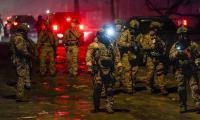Dynamics of LoC escalations
Another round of vicious ceasefire violations has begun to kill and maim new victims, adding to the list of hundreds of innocent men, women and children whose lives have been destroyed in the ritualized killing on the Line of Control, ever since it came into existence, with reverberations for bilateral and regional peace. Over the years, the line (LoC) skirmishes have only served the Indian gamesmanship, reducing it to gladiatorial fighting at a Colloseum to entertain the jeering audience, now on the TVs, through fire breathing TV hosts adding to the serious escalation.
During research for this piece and those done before on the similar subjects "Violations and the LoC and India lays bares coercive diplomacy against Pakistan", former diplomats, general officers, international think tanks believe “India’s consistent refusal to formalize the existing ceasefire agreements and the border management treaties, the 1949 Karachi Agreement, India, Pakistan Border Ground Rules,1960-61, conceived to prevent Cease Fire Violations (CFVs) is the main cause of repeated violations.”
In the absence of overarching agreements, they widely agree the important factors responsible for the CFVs are inadvertent crossings, undemarcated portions of the LoC due to erosion by natural factors absence of formalised ceasefire agreements and on top of it shying away from bilateral engagements.
The situation is like a ritualized killing, carefully calibrated not to go beyond a certain level of escalation, knowing the tolerance level of either side, but one never knows when a heavy mortar or artillery shell and the resulting action-reaction cycle gets out of control of the ground commanders and political leaders. One of the narratives is that a soldier lies in wait to sniff a life out of a suspected infiltrator, but now that the whole border between the two countries is fenced, the infiltration has dropped to a trickle, but generally the victims caught in the lethal fire are often those trying to bring back grazing animals wandering on the other side of the line. A victim could also be just someone who crosses over the border inadvertently. The LoC divides Kashmiri families living on both sides. Marriages and other family get togethers bring together people from both sides, often charting the treacherous terrain, avoiding the bunkers and gun toting troops. In 2012, a grandmother ran away to the Pakistani side from India’s Charonda village triggering an action-reaction sequence of violations that went on for long. This happens because there are no SOPs to cover human crossings on the LoC. The cumbersome process of travelling to the respective countries capitals to get a visa or permission to meet a relative living just across the line is a humanitarian issue neglected by the two states.
In his groundbreaking book "Line on Fire: Ceasefire Violations and India-Pakistan Escalation Dynamics", defence analyst and Prof of Disarmament, Jawaharlal Nehru University, Happymon Jacob, questions if at all the infiltration theory is considered then why most of the ceasefire violations taken place south of Pir Panjal Range which is not the infiltration route.
The death becomes more tragic when the LOC is eroded by regular floods, snowfall or shifting sand dunes when even soldiers patrolling either side lose track of the LoC. This is a regular seasonal feature throughout the year when even the soldiers do not know where they are treading and their lives are cut down by the enemy. This is a sad reflection of deliberate New Delhi’s design not to demarcate the Line of Control. Otherwise at a time when GPS has become a child’s play and India rightfully boasts of being an IT giant, GPS can be used to demarcate the borders but betrays a design for mischief.
The 2,912-km border between the two neighbours is split into the International Boundary, Working Boundary and Line of Control. The 742-km-long LoC falls between Azad Kashmir on Pakistan side and Jammu and Kashmir on the other side. The Working Boundary lies between Sialkot and the disputed Kashmir region. And then there is the International Border, which is internationally recognized, covering the larger parts of Punjab and Sindh in the south.
Happymon Jacob, through extensive research establishes that the predominantly larger, serious and prolonged ceasefire violations (CFVs) occur due to lack of written down bilateral ceasefire agreements that can lead to a massive conflagration. The Musharraf tenure LoC ceasefire from 2003 to 2008 following Pak-India DGMOs hotline communication has not been converted into a written document even in 2019. There is no rational reason except to use the “lacunae” as an instrument for escalation.
The 1949 Karachi Agreement, a holistic document, forbids any defensive structures within 500 meters of the LOC. Same goes for India, Pakistan Border Ground Rules,1960-61. India does not officially recognise any of these and they remain in limbo and create conditions for CFVs. Similarly, there are no SOPs to cover any human crossings on the treacherous LoC either. The two sides last met in 2005 to frame new rules, but nothing happened thereafter.
Pakistan's population, like the Indians, are caught up in the harm’s way due to the classic kafkaesque attitude as the villages of the former are located right up to the Zero Line and in some cases even ahead of the forward military posts. On the Indian side, the population is thinner and so New Delhi is not too pushed for ratify the border agreements.
Consider the magnitude of the tragedies when in 2016, 382 violations were reported and in 2017 Indian forces committed more than 1,970 ceasefire violations. In 2018, 14 civilians died and 65 were injured due to 330 ceasefire violations. But imagine the tragedies of the those who have been left handicapped for life with properties destroyed.
The CFVS showcase the antagonistic relationship between Islamabad and New Delhi determining the ebb and flow of the ceasefire violations. While the LOC has never been peaceful and smaller violations take place even in the best of times, diplomatic engagements largely kept the violations very low. During Gen Musharraf’s peace process 2003-2008 when resolution to the Kashmir issue was being negotiated with offer by making the borders irrelevant. Even from 2010-2012 when the foreign ministers and foreign secretaries kept meeting, the CFVs remained low. Since 2016, Modi has used the rejection of dialogue with Pakistan and disproportionate bombardment on the Line of Control as part of a punitive policy to appease the domestic crowd, the ceasefire violations have both multiplied in intensity and frequency. Pakistan has repeatedly asked New Delhi to formalise the 2003 DGMO phone brokered ceasefire agreements, but India does not want to. Many of these CFVs may not happen if there is a political will to resolve the outstanding issues.
In the existing antagonistic environment, militaries like ours who remain engaged in eyeball to eyeball confrontation are mostly preoccupied with retaining ground advantage and resisting changes to status quo on the LoC, emerging as another important reason for ceasefire violations.
It is diplomatic vandalism of sorts to continue attacking the LoC civilian population with heavy 105mm mortars, and those raining hell through cluster bombs and the 130 and 155mm artillery guns and anti-tank guided missiles. Pakistan has suggested to Indian to lower the caliber of these weapons but New Delhi wants to make it punitive.
India always uses disproportionate shelling on the Pakistani civilians in response to the enhanced Kashmir liberation movement and volatility in the Kashmir valley. The attempts to abolish the already-diluted Article 370 and Article 35A in Kashmir to radically change its demography to the disadvantage of the Kashmiri Muslims is deeply resented. What is to be remembered is that now there are more local Kashmiri militants willing to confront India than before. Pulwama convinced the Kashmiri youth that without a spectacular attack, their cause will never be internationally highlighted. Against this backdrop, the movement for Azadi from India is likely to gain fury with the increased Indian suppression. Previous attempts by Islamic State of Khorasan Province was not allowed by local Kashmiris but how long the militancy can be kept at bay would be a challenge. The LoC in the days to come will see more skirmishes that those living there will have to brace with.
In his book, Happymon Jacob cites: In the past 18 years, at least 10 occasions, “when the ceasefire violations alone” had led to extremely serious diplomatic and military escalation. Against the backdrop of recent Kashmir situation, and without written down and watertight binding ceasefire and border management rules, the Indian gamesmanship could lead to vertical and horizontal escalation, causing bilateral political, diplomatic and military escalation with repercussions for global stability, particularly when the nuclear dynamics are involved.
-
 Apple Foldable IPhone Tipped For 2026 Launch With A20 Pro Chip And C2 Modem
Apple Foldable IPhone Tipped For 2026 Launch With A20 Pro Chip And C2 Modem -
 Meghan Lends Credence To Reports Of Rift With Kim Kardashian On Chicago's Birthday
Meghan Lends Credence To Reports Of Rift With Kim Kardashian On Chicago's Birthday -
 Florida Woman’s Alleged Bid To Bribe Police Ends In Unexpected Discovery
Florida Woman’s Alleged Bid To Bribe Police Ends In Unexpected Discovery -
 James Van Der Beek Strongly Opposes The Idea Of New Year In Winter
James Van Der Beek Strongly Opposes The Idea Of New Year In Winter -
 Elon Musk’s Starlink Rival Eutelsat Partners With MaiaSpace For Satellite Launches
Elon Musk’s Starlink Rival Eutelsat Partners With MaiaSpace For Satellite Launches -
 Fans Feel For Leonardo DiCaprio As He Gets Awkwardly Snubbed: Watch
Fans Feel For Leonardo DiCaprio As He Gets Awkwardly Snubbed: Watch -
 Japan Launches The World’s First Trial To Extract Rare Earth Elements
Japan Launches The World’s First Trial To Extract Rare Earth Elements -
 Prince Harry Breaks Cover In California Amid Tension At Home With Meghan Markle
Prince Harry Breaks Cover In California Amid Tension At Home With Meghan Markle -
 ASAP Rocky Makes Massive Comeback With New Album
ASAP Rocky Makes Massive Comeback With New Album -
 Amanda Seyfried Unveils How Channing Tatum Teased Her On 'Dear John' Set
Amanda Seyfried Unveils How Channing Tatum Teased Her On 'Dear John' Set -
 Blue Moon 2026: Everything You Need To Know
Blue Moon 2026: Everything You Need To Know -
 UN Warns Of 10-year Worst Hunger Crisis In Nigeria After Massive Aid Cuts
UN Warns Of 10-year Worst Hunger Crisis In Nigeria After Massive Aid Cuts -
 Dolly Parton Drops New Version Of Her 1977 Hit 'Light Of A Clear Blue Morning'
Dolly Parton Drops New Version Of Her 1977 Hit 'Light Of A Clear Blue Morning' -
 Redmi Note 15 Pro+5G Set For Global Rollout With Power-packed Features
Redmi Note 15 Pro+5G Set For Global Rollout With Power-packed Features -
 Meghan Markle Sparks Huge Tension With Harry At Home: 'At A Critical Crossroads'
Meghan Markle Sparks Huge Tension With Harry At Home: 'At A Critical Crossroads' -
 Insurrection Act Of 1807: All You Need To Know About Powerful US Emergency Law
Insurrection Act Of 1807: All You Need To Know About Powerful US Emergency Law



